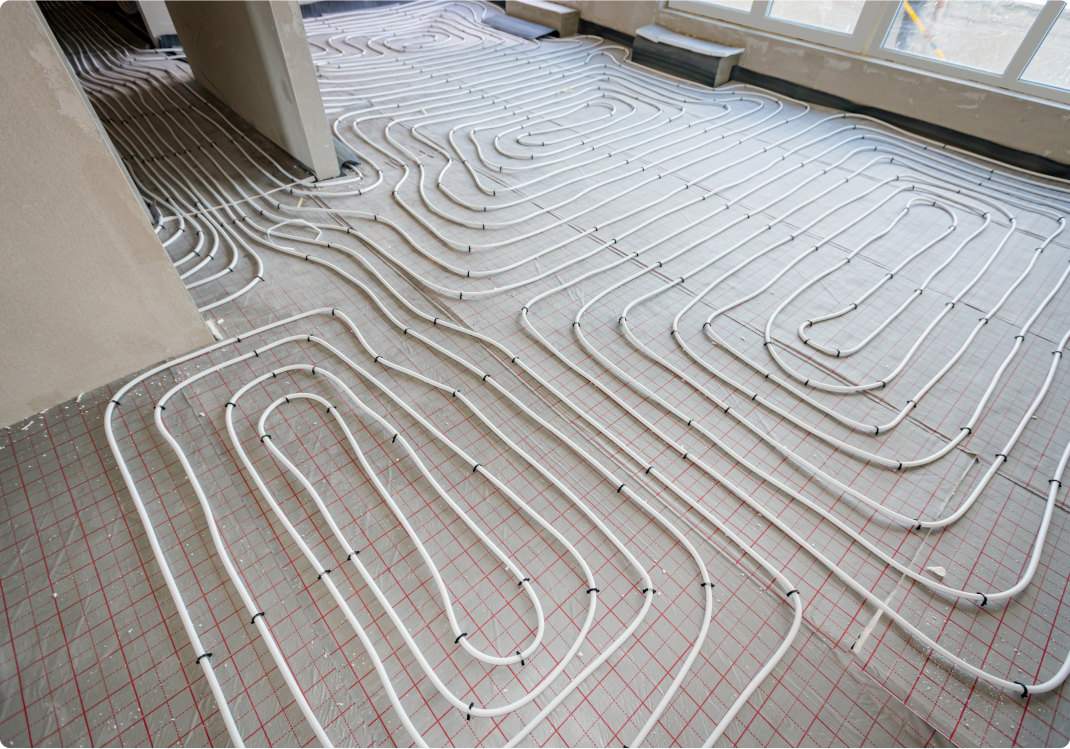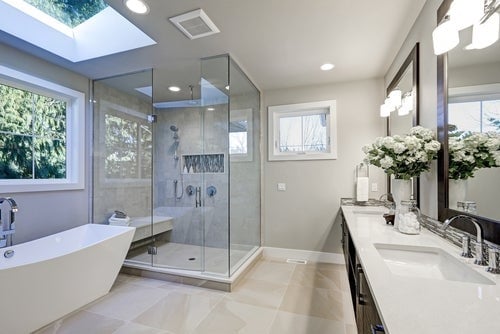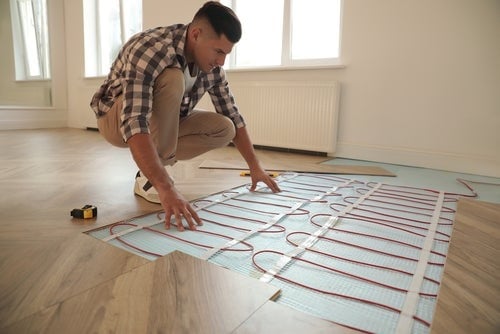Costs and Benefits of In-Floor Heating

Is in-floor heating, or radiant floor heating, worth the cost? Explore the pros and cons of an in-floor heating system and determine if it's right for your home.


Is in-floor heating, or radiant floor heating, worth the cost? Explore the pros and cons of an in-floor heating system and determine if it's right for your home.
If you live in a region that experiences all four seasons, you know just how frigid your floors can be in the winter. You know the routine: You wake up, place your feet on the cold floor, and instantly shiver.
On days like these, the idea of a radiant, or an in-floor, heating system seems less like a luxury item and more like a necessity. Before you commit to this major remodeling project, ask yourself whether radiant floor heating systems are a good idea for your specific home heating needs.
With a forced-air system, your furnace heats the air and then blows it through ducts, which empty through vents and dampers into the various rooms of your home. Because air must be moved or circulated throughout your home, a certain amount of heat loss is inevitable—especially if you fall behind on duct cleaning.
However, with an in-floor heating system, the laws of thermodynamics are on your side. According to Scientific American, heat distribution over the entire surface of a floor heats the lower half of the room, providing warmth at a lower overall temperature—in some cases, up to five degrees cooler—than a conventional heating system.
So, to answer a common question (Do heated floors heat the room?): Yes. Heated floors heat the entire house.
Additionally, radiant heating systems turn on and off less frequently than conventional forced-air HVAC systems or hybrid heating systems, meaning less energy usage. If you do run into problems with your current HVAC system, check out our guide on what to do when your central heating isn’t working.

Homeowners have a variety of options to choose from when powering a floor heating system. Radiant systems are compatible with:
Furnace systems are typically restricted to running on a single energy source, such as heating gas. If the market for that energy source turns volatile, rates can fluctuate, and you can end up paying more to heat your home regardless of how low you set your thermostat.
So, is it expensive to run in-floor heating? Not necessarily. Depending on the energy source used to heat your home, your in-floor heating system may be eligible for state or federal rebates or tax credits.
According to Forbes, homeowners can expect to pay:
These heated floor costs do not include tax and labor so any savings can come in handy. Consult the U.S. Department of Energy’s Database of State Incentives for Renewable Energy to see if there are rebates, loans, or tax deductions available for the installation of a more efficient in-floor heating system where you live.
Furnaces can suck all the humidity out of your home, leaving you with parched, cracked skin and throbbing sinuses. However, in-floor heating systems heat surfaces, not the air itself, making them less likely to cause this issue. (Check out our guide on other strategies to improve air quality in your home.)
Also, since they do not rely upon fans, ducts, and registers to distribute hot air, radiant floor heating systems can reduce the amount of dust and seasonal allergens in your home.
Of course, there are alternative ways to heat your home, and they all have their own benefits and drawbacks, so weigh your options carefully!
Homeowners can create custom solutions to meet their floor heating needs. If you do not wish to install heated floors throughout your entire home, you can instead modularize, choosing only to heat one or several rooms from the ground up. This is a nice option for rooms that tend to be hotter than the rest of the home, like laundry rooms or rooms with south-facing windows.
Explore how a heating system protection plan makes sure you’re not left in the cold.


Unfortunately, heating your floors rather than the air may not be enough to reach the level of comfort you are accustomed to in some circumstances. Be cautious if you have:
It’s best to perform a home energy audit to assess where improvements may be made to increase the efficiency of an existing HVAC system.
If your main rationale for installing an in-floor heating system is that doing so will produce long-term savings by reducing your utility bills, other solutions—such as system zoning or installing solar panels—may be more cost-effective. It’s also important to remember that an in-floor heating system does not help lessen the costs of cooling your home in the summer.

When calculating radiant floor heating costs, you’ll need to factor in the expenses associated with repairing the system.
Flooring and subflooring may have to be removed to assess and address issues with the system. If your floor heating system is hydronic, extra funds may be needed for additional plumbing repairs.
But there’s another important question to consider: How long does in-floor heating last? According to BuildPro, electric underfloor heating can last up to 25 years, while hydronic-heated floors can last up to 50 years—a long time if you’re worried about how long in-floor heating lasts.
If you’re used to cranking up the heater and promptly being rewarded with a rush of heat, heated flooring can be a tough transition. Radiant heat can take hours to spread warmth throughout your home. That’s why many homeowners opt to always leave their radiant flooring on during the winter and just turn it down when it’s not needed.
When wondering whether heated floors are worth it, it’s important to review all the myths and facts about radiant floor heating and determine if it’s suitable for your home.
The biggest benefits of in-floor heating include:
While you can install this type of flooring at any time, it may be advantageous to install it during a home remodel. That way, you can just factor the heated floor cost into your tile or hardwood flooring costs. Learn more about how to choose flooring.
Let American Home Shield® protect your home investment with a home warranty. While we do not cover flooring itself, we do cover:
We offer affordable home warranty plans with a wide range of warranty coverage to help manage the cost to repair or replace your covered home systems and appliances should their parts or components break down due to normal wear and tear. Protect your budget today by checking out our pricing and plans.
AHS assumes no responsibility, and specifically disclaims all liability, for your use of any and all information contained herein.
Have a plan for your home when things don't go according to plan
Shop Home Warranties